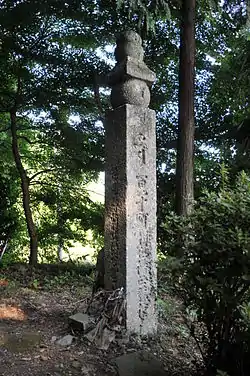Kōyasan chōishi-michi
Kōyasan chōishi-michi (高野山町石道) is a twenty-four kilometre path with a stone marker (ishi) every 109 metres (chō) leading to Kōyasan, Wakayama Prefecture, Japan. Created by Kūkai and within the Kōyasan Chōishi-michi Tamagawa Prefectural Park (高野山町石道玉川峡県立自然公園), it forms part of the UNESCO World Heritage Site: Sacred Sites and Pilgrimage Routes in the Kii Mountain Range.[1][2][3]

Route
The path leads from Jison-in at the foot of Mount Kōya to Danjō Garan, a distance of just under twenty kilometres (one hundred and eighty markers). It is a further four kilometres to Kūkai's mausoleum in the Okunoin (thirty-six markers).[4][5]
Chōishi
The five-tiered stupas were erected in 1285 with donations from the Imperial Family to replace the former wooden posts. One hundred and seventy-nine of the chōishi are original to this period.[1] They are engraved with their number in the sequence from Danjō Garan, as well as the seed syllable of one of the divinities in the Taizōkai Mandala, for the first 180, or the Kongōkai Mandala, for the remainder.[5]
See also
References
- "Advisory Body Evaluation" (PDF). ICOMOS. Retrieved 8 May 2011.
- "Wakayama Prefectural Parks" (PDF). Wakayama Prefecture. Archived from the original (PDF) on 20 July 2011. Retrieved 8 May 2011.
- "Database of National Cultural Properties". Agency for Cultural Affairs. Retrieved 8 May 2011.
- "Pilgrimage Route". Wakayama Tourism Federation. Retrieved 8 May 2011.
- Nicoloff, Philip L. (2008). Sacred Koyasan: A pilgrimage to the Mountain Temple of Saint Kōbō Daishi and the Great Sun Buddha. State University of New York Press. p. 91. ISBN 978-0-7914-7259-0.
External links
- (in Japanese) Chōishi-michi - homepage
- (in Japanese) Chōishi-michi - Map
